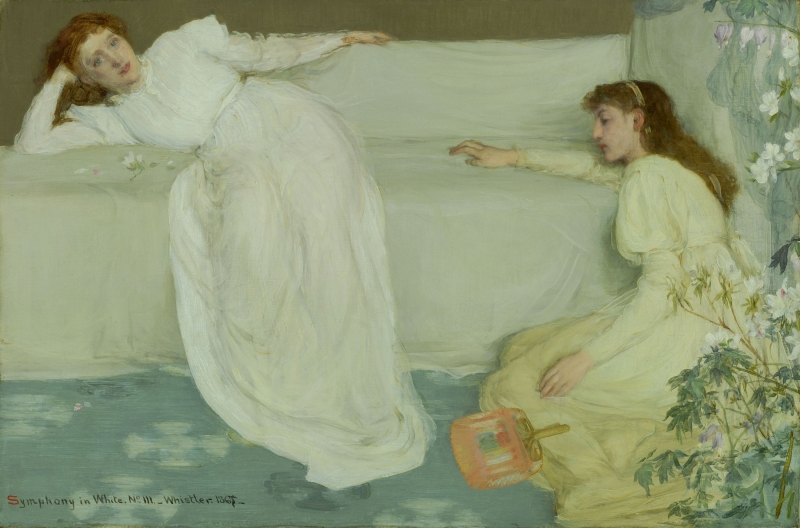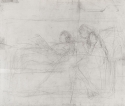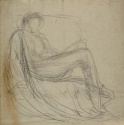Composition
There is a pencil and crayon drawing for the composition, r.: Study for 'Symphony in White No. 3'; v.: Draped figures [M.0322], showing both figures seated on the sofa with their heads close together on the right.
Other drawings suggest Whistler was exploring various poses with seated figures in semi-classical robes. These include Study of a draped reclining woman [M.0326] and Draped figure seated, holding a fan [M.0327].
By the time Whistler wrote to Fantin-Latour in August 1865, and sent him a drawing, Sketch of 'Symphony in White No. 3' [M.0323], the composition had been worked out. He was particularly pleased with the relationship of the arms of the two women to each other and to the back of the sofa, 'Comment trouve la ligne du haut? n'est ce pas bien - et puis l'arrangement de deux bras sur le canapé.' 1 Curiously, some perceived deficiency in the painting of the arms was criticised by an otherwise complimentary art critic in 1867, who considered the figures 'badly drawn.' 2
Hiffernan wore the dress she had worn for 'la fille blanche d'autrefois', Symphony in White, No. 1: The White Girl [YMSM 038]. Whistler also told Fantin that 'quelque fleurs pourpre foncé tombées par terre près la robe jaunâtre' and the carpet was a 'bleu clair tres fin.' 3 Eventually the carpet was subdued to a blue grey, while the azaleas on the right are white, although among them are two sprays of Dutchman's Breeches touched with the palest of purple.
A comparison of the present state of the painting with an early photograph taken 1865/1867, before the date was changed (Lucas Collection, Baltimore), shows several minor alterations, in particular to the drapery behind Milly and to the flowers on the right. It is not known when these alterations were made, but they probably date from early 1867, before the painting was exhibited at the RA.
As several writers pointed out (from 1867 onwards), in Symphony in White, No. 3 [YMSM 061] Whistler's subject matter and technique began to resemble that of Albert Joseph Moore (1841-1893). 4 Moore and Whistler met in 1865. Their mutual admiration resulted in a series of paintings in which it would be very difficult indeed to say who influenced whom. They adopted similar subjects, technique, titles and monograms (see Study of a Female Figure [YMSM 081], Symphony in Blue and Pink [YMSM 086], The Three Girls [YMSM 088], and Tanagra [YMSM 092]). The painting Moore exhibited at the RA in 1865, The Marble Seat (cat. no. 586), could have been the first inspiration for Symphony in White, No. 3 [YMSM 061]. 5 Moore's A Musician (Yale Center for British Art) was also exhibited in the RA in 1867 (cat. no. 235). 6 On the right of Moore's composition are two seated women, in pose relating closely to Whistler's original drawing for Symphony in White, No. 3 [YMSM 061].In 1867 Moore's and Whistler's paintings were hung close together and were compared by art journalists of the time including the art critic of the London Daily News:
'Mr. A. Moore is another of the idealistic painters who deserves mention in connexion with the subject, for his little picture called "The Musicians" (236) – group of figures in classic dresses playing instruments – painted in a delicate key of colour scarcely deeper in tint than that of a cameo. Mr. Whistler, too, in what he calls "A symphony in white, No. 3" (233), furnishes us with another instance of non-consent to the general fashion of painting highly-coloured pictures. Of course these painters are denying themselves a great deal when they limit their palette in this way ; and we must say that it is scarcely worth while to do this for the sake of accomplishing a few dainty gradations of pearly tints.' 7
Likewise the 'Saunterer in Society', reviewing the exhibition in Fun, commented:
'Whistler seems to have been rather cruelly treated. His "Symphony in White; No. III." is evidently part of a harmonious series, which cannot be properly judged by itself, though it is a fine tour de force. A. Moore, who paints in a somewhat similar key, exhibits an admirable picture entitled "Musicians," extremely delicate in colour and clever in drawing.' 8
As Prettejohn comments, in 1867 it was clear that Frederick Leighton (1830-1896), Moore, and Whistler shared similar preoccupations with visual rhythms and music making: Leighton's Spanish Dancing Girl, Moore's A Musician and Whistler's Symphony in White, No. 3, 'experiment with similar compositional type', with an asymmetrical grouping of figures dressed in semi-classical robes 'arranged on a bench in a shallow foreground space ... All three are ambiguous in period location.' 9
Technique
It is painted with fairly thin paint, of a creamy consistency, with expressive, flowing brushstrokes. The brushstrokes on the skirt are laid over one another, the edges of each stroke still showing the underlying brushwork. The modelling of the legs and dress is shown convincingly, with the weight of the body being clearly conveyed. The face of the woman at left was painted with much smaller, pointed sable brushes, in careful but expressive brushstrokes; the warm colours of the skin contrast with her bright blue eyes. The model at right is dressed in white of a more yellow shade, slightly browned towards the lower edge, where it is in shadow. 10
Walter Richard Sickert (1860-1942), writing it must be said in response to the adoring tone of the Pennells' 1908 biography of Whistler, was extremely critical of Whistler's technique in this painting:
'A bad picture … badly composed, badly drawn, badly painted … The folds of the drapery are expressed by ribbons of paint in the direction of the folds themselves, with hard edges to them. Only painters can quite understand the depth of infamy confessed in this last description. It means that the drapery is no longer painted, but intended.' 11 And yet, he added, 'Something in the expression of the eyes of the girl on the sofa has preserved for us a hint of the young man's admiration.' 12
Conservation History
It was cleaned and varnished without the owner's approval, before being exhibited at Goupil's in 1892; Huth refused outright to pay any costs, 'you should defray any expense you may have deemed necessary for the rendering of your Exhibition more attractive, I declined to pay it, and I must adhere to my decision.' 13 The painting, according to Whistler, had been returned 'through my care, in a state of perfection - beautiful to look upon.' 14
Frame
1865: The original frame has not been located.
1870s: Flat Whistler frame with painted Maltese Cross Pattern, still visible under the gilding, dating from ca 1871/1873. The original decoration painted on the frame dates from the early 1870s, perhaps from the 1873 exhibition. [FD] 33 7/8 x 44" (86.0 x 111.7 cm), [MW] 7 ¼" (18.4 cm). 15
1892: Professor McLaren Young thought this decoration might have been gilded over at the time of the Goupil exhibition. The frame was abraded during transport back from the Goupil show and may have been repaired at that time. 16
Notes:
1: Whistler to Fantin-Latour, 16 August [1865], GUW #11477.
2: Unidentified press cutting, [May/June 1867], GUL Whistler PC1, p. 55.
3: Whistler to Fantin-Latour, 16 August [1865], op. cit.
4: Pennell 1908 [more] , vol. 1, p. 145: 'Some see, at this period, the influence of Albert Moore, which, if it existed at all, was as ephemeral and superficial as Rossetti's. It could be argued with more truth that Whistler influenced Albert Moore, who, for at least two pictures, Harmony of Orange and Pale Yellow, Variation of Blue and Gold, borrowed Whistler's titles.'
5: The Marble Seat, Sotheby's, New York, 5 May 2911 (lot 76); see also Baldry 1894 [more] , f.p. 28; Asleson, Robyn, Albert Moore, London, 2000, pp. 38, 77, 79-81, 85, 89, 92, 189, 196, repr. p. 78A; Staley, Allen, The New Painting of the 1860s, Between the Pre-Raphaelites and the Aesthetic Movement, New Haven and London, 2011, pp. 101, 127-30, 132, 146, 171, 173, 329, repr. p. 127, pl. 115.
6: See Baldry 1894 [more] , f.p. 36.
7: 11 June 1867, GUL Whistler PC1, p. 13.
8: 'Town Talk, By the Saunterer in Society', Fun, 18 May 1867, p. 100 (GUL Whistler PC 1, p. 35).
9: Prettejohn, Elizabeth, Beauty and Art : 1750-2000, Oxford, 2005, p. 142. See also Susan Casteras's review of same, 10 December 2008, online at http://www.caareviews.org.
10: See MacDonald, Margaret F., Joanna Dunn, and Joyce H. Townsend, 'Painting Joanna Hiffernan', in Margaret F. MacDonald (ed.), The Woman in White: Joanna Hiffernan and James McNeill Whistler, New Haven and Washington, 2020, pp. 33-45.
11: Sickert 1908 B [more] ; see W. Sickert 2000 [more] , p. 185.
12: Ibid.
13: L. Huth to Whistler, 20 April 1892, GUW #02245.
14: Whistler to E. G. Kennedy, 4 February 1894, GUW #09715.
15: Dr S. L. Parkerson Day, Report on frames, 2017; see also Parkerson 2007 [more] .
Last updated: 9th June 2021 by Margaret












